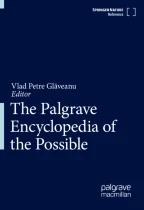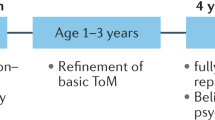Theory of Mind

The theory of mind (ToM) refers to how people understand their own thoughts and feelings and those of other beings. It is a crucial cognitive mechanism for social interactions and communication. It helps us to predict, to explain, and to manipulate behaviors or mental states. Moreover, this skill is shared by almost all human beings beyond early childhood.
The literature presents different explicit false-belief tasks as a means of investigating ToM in children (e.g., one of the most famous is known as the Sally-Anne task). Although children younger than 4 years usually fail in these explicit tasks, it cannot be excluded that some less complex forms of understanding mental states develop earlier. So, in order to investigate the precursors that anticipate the emergence of a more mature representational system, many recent studies on infants’ beliefs have demonstrated, in the last decade, a very early sensitivity specifically to the false beliefs of others by using implicit looking-time tasks. This entry starts with the definition of the theory of mind and its history, before moving on to summarize developmental research in this area. Finally, it focuses on the relation between theory of mind and the possible with some reflections on how an increasing consciousness of the variety of situations that the possible presents to us could allow people to choose the best alternative for themselves and others.
This is a preview of subscription content, log in via an institution to check access.
Access this chapter
Subscribe and save
Springer+ Basic
€32.70 /Month
- Get 10 units per month
- Download Article/Chapter or eBook
- 1 Unit = 1 Article or 1 Chapter
- Cancel anytime
Buy Now
Price includes VAT (France)
eBook EUR 802.49 Price includes VAT (France)
Hardcover Book EUR 843.99 Price includes VAT (France)
Tax calculation will be finalised at checkout
Purchases are for personal use only
Similar content being viewed by others

Theory of Mind
Chapter © 2020

Early Theory of Mind Development: Are Infants Inherently Altercentric?
Chapter © 2021

Foundations of theory of mind and its development in early childhood
Article 07 March 2022
Notes
For the sake of brevity, the relation between ToM and various other pathologies has not been included in this entry; for example, the importance of the ToM’s deficits in autism has not been covered; see Baron-Cohen (2000), Fletcher-Watson and Happè (2019), Mitchell (1997).
References
- Apperly, I. A., & Butterfill, S. A. (2009). Do humans have two systems to track beliefs and belief-like states? Psychological Review, 116, 953–970. ArticleGoogle Scholar
- Astington, J. W., Harris, P. L., & Olson, D. R. (1988). Developing theories of mind. Cambridge: Cambridge University Press. Google Scholar
- Baillargeon, R., Scott, R. M., & He, Z. (2010). False-belief understanding in infants. Trends in Cognitive Sciences, 14(3), 110–118. ArticleGoogle Scholar
- Baron-Cohen, S. (1991). Precursors to a theory of mind: Understanding attention in others. In A. Whiten (Ed.), Natural theories of mind: Evolution, development and simulation of everyday mindreading (pp. 233–251). Oxford: Blackwell. Google Scholar
- Baron-Cohen, S. (2000). Theory of mind and autism: A fifteen year review. In S. Baron-Cohen, H. Tager-Flusberg, & D. J. Cohen (Eds.), Understanding other minds: Perspectives from developmental cognitive neuroscience (2nd ed.). Oxford: Oxford University Press. Google Scholar
- Baron-Cohen, S., Leslie, A. M., & Frith, U. (1985). Does the autistic child have a “theory of mind”? Cognition, 21(1), 37–46. ArticleGoogle Scholar
- Bretherton, I., McNew, S., & Beeghley-Smith, M. (1981). Early person knowledge as expressed in gestural and verbal communication: When do infants acquire a “theory of mind”? In M. E. Lamb & L. R. Sherrod (Eds.), Infant social cognition (pp. 333–373). Hillsdale: Lawrence Erlbaum. Google Scholar
- Call, J., & Tomasello, M. (2008). Does the chimpanzee have a theory of mind? 30 years later. Trends in Cognitive Sciences, 12(5), 187–192. ArticleGoogle Scholar
- Callaghan, T., Rochat, P., Lillard, A., Claux, M. L., Odden, H., Itakura, S., … Singh, S. (2005). Synchrony in the onset of mental-state reasoning: Evidence from five cultures. Psychological Science, 16, 378–384. Google Scholar
- Doherty, M. (2009). Theory of mind. Philadelphia: Psychology Press. Google Scholar
- Erikson, M. G. (2007). The meaning of the future: Toward a more specific definition of possible selves. Review of General Psychology, 11(4), 348–358. ArticleGoogle Scholar
- Fletcher-Watson, S., & Happè, F. (2019). Autism: A new introduction to psychological theory and current debate. New York: Routledge. BookGoogle Scholar
- Fodor, J. A. (1978). Propositional attitudes. The Monist, 61, 501–523. ArticleGoogle Scholar
- Frye, D., & Moore, C. (1991). Children’s theories of mind. Mental states and social understanding. Hillsdale: Lawrence Erlbaum. Google Scholar
- Glăveanu, V. P. (2018). The possible as a field of inquiry. Europe’s Journal of Psychology, 14(3), 519–530. ArticleGoogle Scholar
- Heyes, C. (2014). False belief in infancy: A fresh look. Developmental Science, 17(5), 647–659. ArticleGoogle Scholar
- Kovács, Á. M., Téglás, E., & Endress, A. D. (2010). The social sense: Susceptibility to others’ beliefs in human infants and adults. Science, 330, 1830–1834. ArticleGoogle Scholar
- Lewis, C., & Mitchell, P. (Eds.) (1994). Children’s early understanding of mind: Origins and development. Hillsdale, NJ: Erlbaum. Google Scholar
- MacNamara, J., Baker, E., & Olson, C. (1976). Four-year-olds’ understanding of pretend, forget, and know: Evidence for propositional operations. Child Development, 47, 62–70. https://doi.org/10.2307/1128283. ArticleGoogle Scholar
- Mitchell, P. (1997). Introduction to theory of mind: Children, autism and apes. London: Edward Arnold Publishers. Google Scholar
- Mitchell, P., & Lacohée, H. (1991). Children’s early understanding of false belief. Cognition, 39, 107–127. ArticleGoogle Scholar
- Moore, C. (1996). Theories of mind in infancy. British Journal of Developmental Psychology, 14, 19–40. ArticleGoogle Scholar
- Onishi, K. H., & Baillargeon, R. (2005). Do 15-month-old infants understand false beliefs? Science, 308(5719), 255–258. ArticleGoogle Scholar
- Rakoczy, H. (2012). Do infants have a theory of mind? British Journal of Developmental Psychology, 30, 59–74. ArticleGoogle Scholar
- Rakoczy, H. (2017). Theory of mind. In B. Hopkins, E. Geangu, & S. Linkenauger (Eds.), The Cambridge encyclopedia of child development (pp. 505–512). Cambridge, UK: Cambridge University Press. ChapterGoogle Scholar
- Seligman, M. E. P., Railton, P., Baumeister, R. F., & Sripada, C. (2013). Navigating into the future or driven by the past. Perspectives on Psychological Science, 8(2), 119–141. ArticleGoogle Scholar
- Senju, A., Southgate, V., Snape, C., Leonard, M., & Csibra, G. (2011). Do 18-month-olds really attribute mental states to others? Psychological Science, 22(7), 878–880. ArticleGoogle Scholar
- Shultz, T. R., & Cloghesy, K. (1981). Development of recursive awareness of intention. Developmental Psychology, 17, 456–471. ArticleGoogle Scholar
- Shultz, T. R., Wells, D., & Sarda, M. (1980). The development of the ability to distinguish intended actions from mistakes, reflexes, and passive movements. British Journal of Social & Clinical Psychology, 19, 301–310. ArticleGoogle Scholar
- Song, H., & Baillargeon, R. (2008). Infants’ reasoning about others’ false perceptions. Developmental Psychology, 44(6), 1789–1795. ArticleGoogle Scholar
- Southgate, V., Senju, A., & Csibra, G. (2007). Action anticipation through attribution of false belief by 2-year-olds. Psychological Science, 18(7), 587–592. ArticleGoogle Scholar
- Surian, L., & Geraci, A. (2012). Where will the triangle look for it? Attributing false beliefs to a geometric shape at 17 months. British Journal of Developmental Psychology, 30(1), 30–44. ArticleGoogle Scholar
- Surian, L., Caldi, S., & Sperber, D. (2007). Attribution of beliefs by 13-month-old infants. Psychological Science, 18(7), 580–586. ArticleGoogle Scholar
- Wellman, H. M. (2017). The development of theory of mind: Historical reflections. Child Development Perspectives, 11, 207–214. ArticleGoogle Scholar
- Wellman, H. M., Cross, D., & Watson, J. (2001). Metaanalysis of theory-of-mind development: The truth about false belief. Child Development, 72, 655–684. ArticleGoogle Scholar
- Whiten, A. (1991). Natural theories of mind. Oxford: Basil Blackwell. Google Scholar
- Wimmer, H., & Perner, J. (1983). Beliefs about beliefs: Representation and constraining function of wrong beliefs in young children’s understanding of deception. Cognition, 13(1), 103–128. ArticleGoogle Scholar
- Zittoun, T., & de Saint-Laurent, C. (2015). Life-creativity: Imagining one’s life. In V. P. Glăveanu, A. Gillespie, & J. Valsiner (Eds.), Rethinking creativity: Contributions from cultural psychology (pp. 58–75). London: Routledge. Google Scholar
Author information
Authors and Affiliations
- Department of Psychology and Cognitive Sciences, University of Trento, Trento, Italy Laura Franchin
- Laura Franchin


